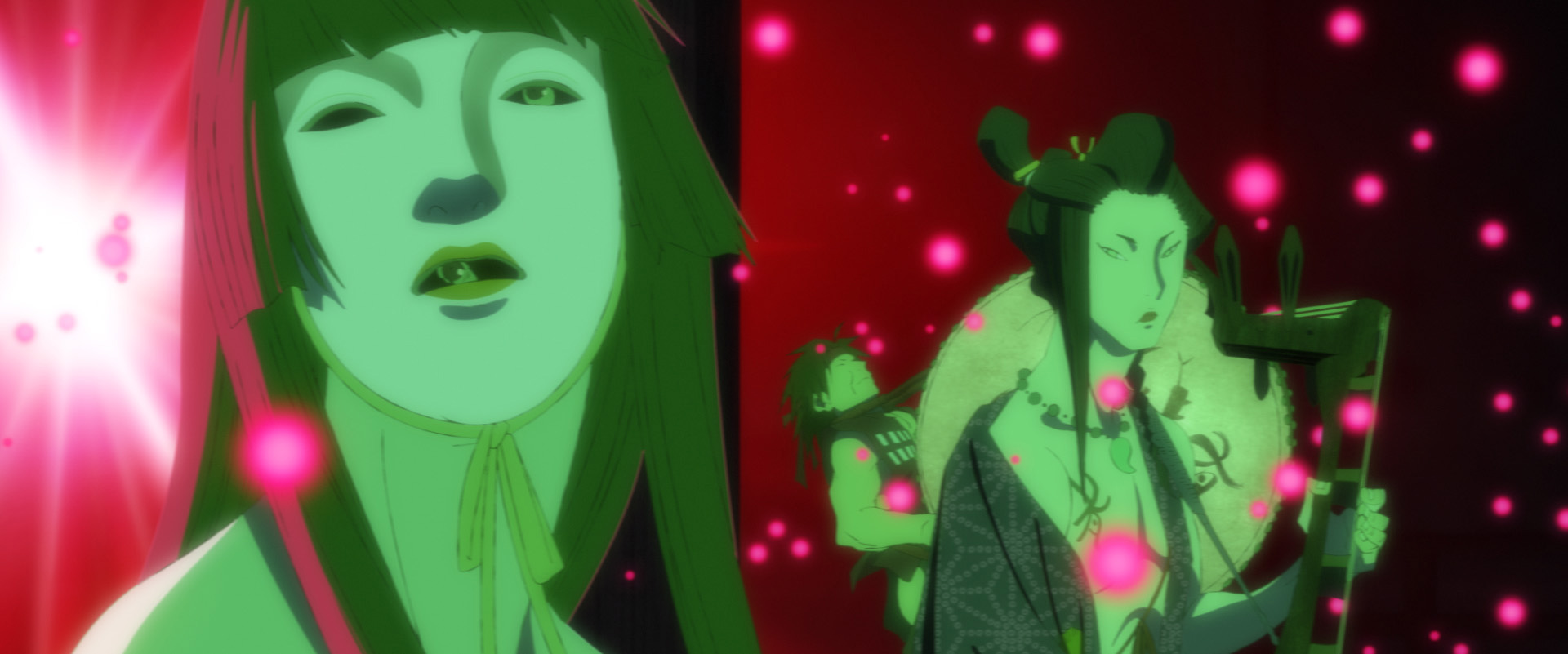Director Masaaki Yuasa and screenwriter Akiko Nogi’s adaptation of Hideo Furukawa’s novel The Tale of the Heike: The Inu-oh Chapters finishes with a couple screens of text describing its titular Noh performer’s final years of success, despite his name being all but forgotten in comparison to the shōgun Ashikaga Yoshimitsu’s personal favorite. It’s why these three have brought the story of Inu-oh to life—to ensure his name, and that of his friend Tomona from Dan-no-ura, a blind biwa-playing priest, won’t disappear again. What better way to do so than a 14th-century anachronistic rock opera set during Japan’s Muromachi period, courtesy two cursed men who dare give voice to the voiceless and subsequently free themselves from the chains that society uses to bind them?
Though the characters exist 600 years in the past, their story begins about 300 years earlier during a war between the Genji and Heike. The former ultimately proves the victor. The latter perishes at sea. And yet the nation is still divided—something Ashikaga (Tasuku Emoto) hopes to rectify. It’s said that doing so demands the possession of three fantastical objects that had all been lost in the bloodshed. One happens to be hidden in Dan-no-ura, Tomona’s (Mirai Moriyama) hometown. Another resides in Kyoto, where Inu-oh (Queen Bee lead singer Avu-chan) was raised. It’s thus no surprise that both boys are unnaturally afflicted by hardship through proximity. Tomona inexplicably goes blind during a tragic search for a sword. Inu-oh is born with numerous physical deformities.
So of course they also cross paths and change the course of history. Tomona apprentices with a biwa-playing priest of a state-sanctioned order of musical storytellers based in the capital. It’s there that he runs into a rambunctious Inu-oh found running around and terrorizing the neighbors by removing his gourd mask (he can’t see out of regular masks due to his eyes being positioned vertically rather than horizontally upon his face). Because Tomona is blind he doesn’t scream and flee. Since Inu-oh rarely gets to talk to anyone he embraces the chance to make a friend. Soon they discover they both have the same ambition to tell new stories about the Heike. They want to create unique music and enthrall the masses with performances unlike any seen before.
Yuasa’s decision to choose rock for an era of controlled motion and artistic reverence is as unorthodox as it is electric. The priests start calling Tomona a “prostitute” as he grows his hair long (they’re all bald) and wears make-up to rile crowds with his animated biwa strumming. Think Back to the Future with Marty McFly going wild onstage, only there’s no “But your kids will love it” equivalent here. Everyone already does. And he’s just the hype man; Inu-Oh delivers the real show. While his father—a renowned Sarugaku artist (and Noh’s precursor) played by Kenjiro Tsuda—upholds the dance form’s traditional stoicism, his audience flees towards the new heartthrob: the son he refused to teach under the belief that nobody could ever love a monster (himself included).
For whatever reason, though, the more Inu-oh dances, the fewer deformities he has. Something about what he’s doing is lifting whatever curse befell him in the womb. This is a supernatural tale, and thus spirits are found all around them—whether in Tomona’s father (Yutaka Matsushige) or the fallen Heike soldiers desperate to be remembered. Theirs are the new songs Inu-oh sings. These spirits tell him of their adventures; he reminds Japan of the shōgun’s nameless and faceless victims. Tomona even creates a traveling troupe to spread the magic well beyond Kyoto’s borders until Inu-oh becomes big enough that Ashikaga’s wife is requesting a performance. As each song completes, another body part is “normalized.” And so too is the idea that the Heike weren’t villains, but martyrs instead.
This is the main point of conflict, yet only lasts for about the final 20 minutes or so when Ashikaga threatens to stop Inu-oh and Tomona from upsetting the status quo. Until that point, Inu-oh is mostly vibes—one concert after another with more elaborate pyrotechnics and sing-alongs as the crowd really leans into the participatory nature of what these men are doing. Just because it might seem narratively superficial due to the cyclical nature of that progression, however, it’s all necessary insofar as showing us their physical and stylistic evolutions. It’s fun too. The juxtaposition of what they’re doing in such an antiquated setting is intriguing enough to keep our attention. The music being catchy and the performances being invigorating is icing on the cake.
It might also cultivate misleading expectations. Because while there’s death and abuse during the first two-thirds of this film, Inu-oh proves itself a feel-good tale of self-made identity and redemption. As such, I was not quite expecting to find it skewing very dark during the finale. Revelations of nightmarish betrayal are one thing, but I’m talking a gruesomely bloody demise and some powerful moments of civil disobedience creating unspeakable violence. I cannot say it’s not effective, though. The abruptness and contextual relevance of these scenes make them crucial to the whole and the animation and compositions are never more memorable. Not to say Taiyo Matsumoto’s character designs, the Noh performances, or Yuasa’s direction aren’t themselves. This is a well-made, idiosyncratic anime breathing newfound life into ancient history.
Inu-oh screened at the Fantasia International Film Festival and opens theatrically on August 12.

